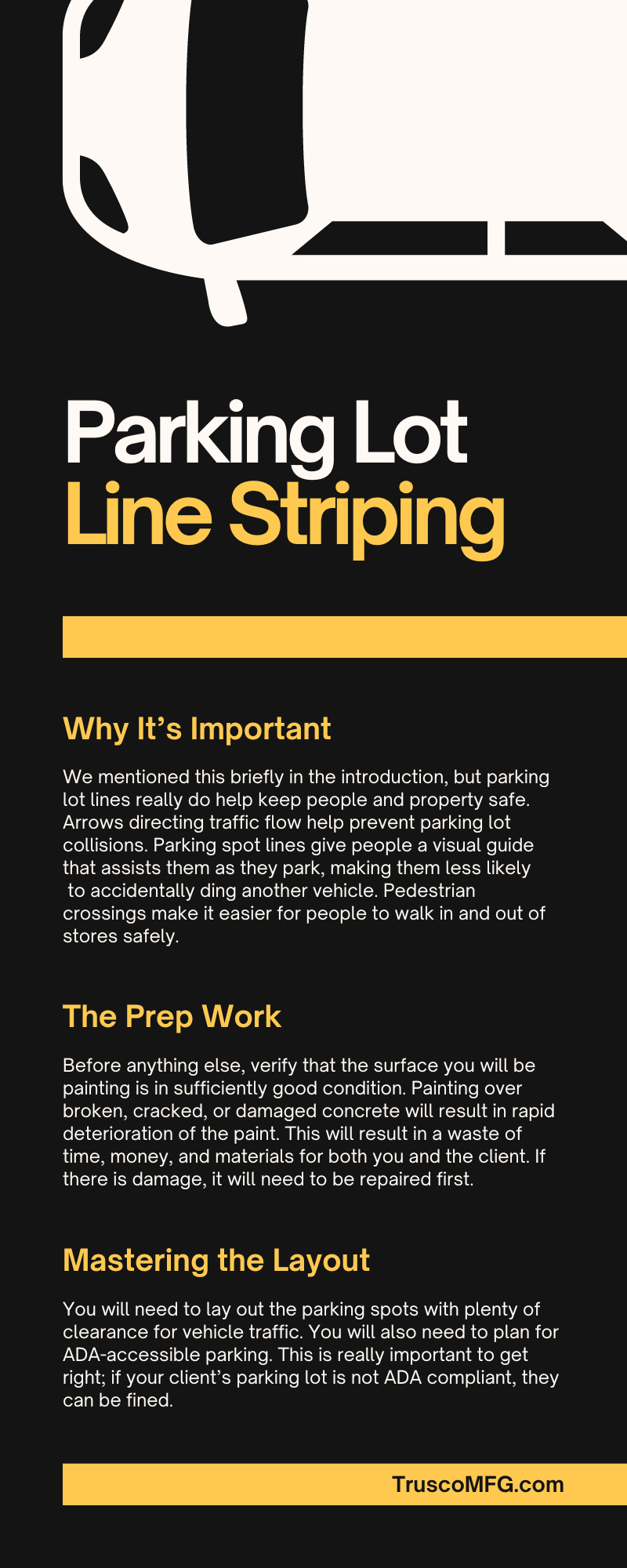
As you go about your day—driving to work, running errands, or picking up the kids from school—you likely don’t think twice about the lines marking the streets or designating the parking lots. However, these seemingly inconsequential lines are extremely important. They keep traffic flowing as it should instead of colliding with other vehicles.
The lines marking the parking lots are equally as important, silently instructing vehicles where to go and where to park. People who are not in the line striping industry have likely never thought twice about their importance or their upkeep.
However, you’re not like most people. If you’re looking to get into the line striping industry, you’ll need to master the basics before you can start taking clients. Our ultimate guide to parking lot striping will get you well on your way.
Why It’s Important
We mentioned this briefly in the introduction, but parking lot lines really do help keep people and property safe. Arrows directing traffic flow help prevent parking lot collisions. Parking spot lines give people a visual guide that assists them as they park, making them less likely to accidentally ding another vehicle. Pedestrian crossings make it easier for people to walk in and out of stores safely.
And that’s not even the most important part. Accessible parking is often clearly indicated with blue line striping, making it possible for disabled individuals to shop, work, and move through the world safely. None of this would be possible without an element as simple as painted lines on concrete.
The Prep Work
Before you begin painting, it is extremely important to adequately prepare the parking lot you’ll be working on. There are a few things you need to take care of first.
Before anything else, verify that the surface you will be painting is in sufficiently good condition. Painting over broken, cracked, or damaged concrete will result in rapid deterioration of the paint. This will result in a waste of time, money, and materials for both you and the client. If there is damage, it will need to be repaired first.
Make sure the parking lot is clear while you are painting. If you plan to paint during business operating hours, block off the parking lot with traffic cones or tape to prevent cars from driving into the parking lot. This will protect both you and your hard work. Verify that other parking arrangements are available so that customers are still able to access the business.
Finally, clean the entire area. Any dirt or debris must be cleared away before you begin painting. If you can avoid it, do not pressure wash the lot. This will wet the concrete and force you to wait to begin painting until after it has dried. Only pressure-wash if the dirt will not come off through other means.
Instead, use a broom to sweep the area clean. A large push broom is a good option for most loose items. Use a steel brush attachment to scrape free any stubborn debris.
Mastering the Layout
Every lot is unique, so we can’t give you a tried-and-true formula. However, we can give you the basics.
You will need to lay out the parking spots with plenty of clearance for vehicle traffic. You will also need to plan for ADA-accessible parking. This is really important to get right; if your client’s parking lot is not ADA compliant, they can be fined.
The typical parking spot size is 9 by 18 feet. The average compact spot is between 7.5 and 8.5 feet wide and 15 to 16 feet long. ADA-accessible parking spots must be 8 feet across, with at least 5 feet of clearance alongside. The lines you paint should be 4 inches wide.
With these required measurements, you’ll need to map out a parking lot layout based on the lot’s dimensions. The number of regular and ADA-accessible spots you can fit will be based on this.
Before you begin painting, use chalk or string lines to guide your paint striping machine. These markers will make it clear where your lines should go, so that you don’t make any errors.
Painting Basics
The basics of painting start with your line striping machine. Hopefully, you have a good one to work with. Bad-quality paint stripers can clog and make your lines spotty and thick.
Choosing Your Paint
You’ll need to choose the right paint to work with. There are several different options.
Water-based paint is the most affordable and eco-friendly option. However, it will need to be applied more often, as it doesn’t hold up to harsh weather as well. Thermoplastic paint does a better job against the elements, but it costs more and takes longer to apply. Oil-based paint is more affordable than thermoplastic and longer lasting than water-based, but less eco-friendly. It is also durable against freezing weather.
Painting Straight Lines
Painting straight lines can be trickier than it may seem. The key is all in how you line up your machine. Now that you have your guiding chalk lines in place, line up your paint striper. The tip guard should sit just to the side of the chalk line. Running the paint over the middle of the line will usually end with wiggly lines. Instead, paint a solid line of paint parallel to the chalk line you’ve drawn.
When you start painting, don’t rush. The machine will get up to speed in a few short feet. You do not need to run or rush the first few feet to get an even paint distribution. Instead, start a steady, comfortable walking pace. Keep your eye on the chalk line ahead of you, and take it easy. Keeping at a consistent pace will ensure that you get crisp, sharp, and professional lines in your parking lot.
Trusco Manufacturing Company is proud to provide high-quality paint striping machines suitable for everything from parking lots to football fields. No matter what you’re painting, we’ve got your back. Our reliable, durable machines will ensure that your paint striper is never the thing that makes your job difficult.
We hope you enjoyed our ultimate guide to parking lot line striping. We have plenty more tips and tricks where these came from, so check back in on our blog if you’d like to learn more.

